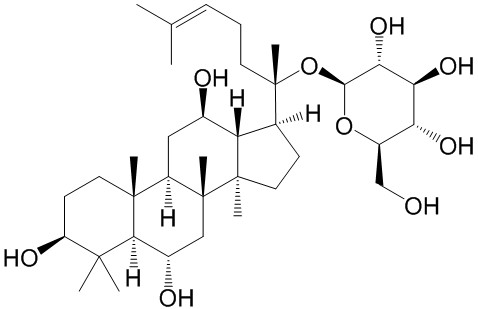Home
Products
Ginsenoside F1



| Product Name | Ginsenoside F1 |
| Price: | $62 / 20mg |
| Catalog No.: | CN08084 |
| CAS No.: | 53963-43-2 |
| Molecular Formula: | C36H62O9 |
| Molecular Weight: | 638.88 g/mol |
| Purity: | >=98% |
| Type of Compound: | Triterpenoids |
| Physical Desc.: | Powder |
| Source: | The roots of Panax ginseng C.A.Mey. |
| Solvent: | DMSO, Pyridine, Methanol, Ethanol, etc. |
| SMILES: | OC[C@H]1O[C@@H](O[C@]([C@H]2CC[C@@]3([C@@H]2[C@H](O)C[C@H]2[C@@]3(C)C[C@@H]([C@@H]3[C@]2(C)CC[C@@H](C3(C)C)O)O)C)(CCC=C(C)C)C)[C@@H]([C@H]([C@@H]1O)O)O |
| Contact us | |
|---|---|
| First Name: | |
| Last Name: | |
| E-mail: | |
| Question: | |
| Description | Ginsenoside F1, an enzymatically modified derivative of Ginsenoside Rg1, demonstrates competitive inhibition of CYP3A4 activity and weaker inhibition of CYP2D6 activity. |
| Target | CYP3A4 |
| In Vitro | Ginsenoside F1 has been shown to flaunt anticancer, anti-aging, and antioxidant effects and has demonstrated competitive inhibition of CYP3A4 activity and weaker inhibition of CYP2D6 activity. The cell viabilities are 68% at the highest concentration of ginsenoside F1 (200μM) in MTT assays[1]. |
| In Vivo | ApoE-/- mice are fed a high fat diet and orally treated with Ginsenoside F1 (50 mg/kg/day) for 8 weeks. Ginsenoside F1 treated mice significantly reduce the lesion size compared with model group mice[2]. |
| Cell Assay | B16BL6 cells are cultured in Dulbecco's modified Eagles medium supplemented with 10% fetal bovine serum and 1% Penicillin-Streptomycin at 37°C in a humidified 95% air/5% CO2 atmosphere. Cell viability is determined for Ginsenoside F1 and metabolite 1 using MTT conversion to formazan. Cells are seeded at a density of 1×105 cells/well in a 96-well plate, cultured for 24 h, and treated with various concentrations from 1 μM to 200 μM of Ginsenoside F1 and metabolite 1 for 5 d. Finally, 10 μL of MTT (5 mg/mL in PBS) is added to each well. Cells are incubated at 37°C for 3 h, and then DMSO (100 μL) is added to dissolve the formazan crystals. The absorbance is measured at 570 nm with the reference wavelength of 630 nm using an ELISA reader[1]. |
| Animal Admin | Mice[2] Six-week-old (17±1 g) male C57BL/6 mice and ApoE-/- mice with a C57BL/6 background are maintained in a temperature-controlled facility (temperature: 22±1°C; humidity: 60%) with a 14 h light/10 h dark cycle in conventional cages. Forty mice are randomly divided into four experimental groups (n=10/group): (I) C57BL/6 N mice, the control group; (II) ApoE-/- mice group; (III) ApoE-/- mice+ Ginsenoside F1 group; (IV) ApoE-/- mice+Probucol group. All mice are fed with a high fat diet (HFD, 0.3% cholesterol and 20% pork fat) for 8 weeks. Ginsenoside F1 (50 mg/kg/day, i.g.) and Probucol (2 g/kg, i.g.) are dissolved in carboxymethyl cellulose sodium (CMC-Na). Oral administration is given to mice every day for 8 weeks. The control and model groups receive the aseptic 0.5% CMC-Na treatment every day (i.g., 0.1 mL/10g) [2]. |
| Density | 1.2±0.1 g/cm3 |
| Boiling Point | 751.7±60.0 °C at 760 mmHg |
| Flash Point | 408.4±32.9 °C |
| Exact Mass | 638.439392 |
| PSA | 160.07000 |
| LogP | 3.80 |
| Vapour Pressure | 0.0±5.7 mmHg at 25°C |